Panelists (left to right) Jim Huber from Office Depot, Raffi Vartian from SignageLive, Bill Othick of BOI Solutions, Richard Hutton from Samsung, Jim Vair of Capital Networks, and NewBay Media’s David Keene analyzed legacy TCO models, and then turned to hardware and software advancements that now allow the streamlining of digital signage platforms, for reduced TCO.
With so many events, exhibits, classroom sessions, training sessions and more taking place at InfoComm last week, chances are you missed the Simplifying Digital Signage Roundtable that took place Wednesday at InfoComm in Orlando, where I moderated as panelists Jim Huber from Office Depot, Bill Othick of BOI Solutions, Richard Hutton from Samsung, Raffi Vartian from SignageLive, Jim Vair of Capital Networks analyzed legacy TCO models for digital signage, and then turned to hardware and software advancements that now allow the streamlining of digital signage platforms, for reduced TCO.
As moderator, I kicked off the discussion by raising the questions:
• Beyond Market Share– what new markets are seeking solutions?
• Where is it smarter to simplify, not complicate?
• The business of the technology– looking at TCO in a changing landscape– are there new models now, and for the future?
Having been covering the AV, and digital signage industry for a while, I’ve seen over and over, the problem of commoditization rear its head. And every time it does, I always go back to economic fundamentals: How do you increase sales, in any industry? Well, you can increase your market share, right? Obviously. But you can also increase your sales even if your market share declines. How? If the market itself is growing. Today, even as we talk about new technology, at the heart of the discussion is the question of market growth itself– if we look at expanding the digital signage market, to areas where a new group of customers seek simpler solutions. And those new market growth areas– as well as some existing ones– could benefit from simpler solutions, not more complex ones. And if we did that, what would that do to TCO as we’ve known it, in the digital signage landscape?
The panel set the stage for answers to the above questions, by putting the debate in historical context:
• Massive economies of scale led to rapidly decreasing cost/prices for LCD panels = the proliferation of digital signage.
• The same economies + Moore’s Law dynamics on the “media player” side = we can now do far more with computing power.
• Big advancements first in embedded PCs and Open Pluggable Specification (OPS) platforms, and more recently in high-horsepower SoC technology (system on a chip technology).
Panelists Jim Huber and Bill Othick brought the integrator’s perspective. Jim Huber, CTS, is Solutions Development Manager / Managed Print Services and Technology for Office Depot. Previously, he was the Director of Sales & Marketing for NOR-COM. Over the past 20+ years, Jim has provided technology and Managed Print Solutions for a variety of clients, with a keen focus on Digital Signage. As part of these efforts, NOR-COM installed a number of robust digital signage systems throughout both Proctor & Gamble’s 1.6 million square foot global health care headquarters located just north of Cincinnati, Ohio and numerous corporate, legal, manufacturing, educational and health care facilities across the United States. Jim is on the Board of Directors of NSCA and has held numerous other positions within both InfoComm and other related organizations.
(Bill) Othick is Principle, BOI, with thirty years of active involvement with interactive technology, Bill has developed Acoustical Counter Measures for DIA, and Global Secure Video Conferencing Network for DOD. He was responsible for merging communications & compressed video on NASA’s Space Shuttle, and for the Collaboration Room of the Future, for P&G– among many other accomplishments.
Huber launched a discussion of how, if we could look at new digital signage systems with simplified– and fewer– hardware components, we could significantly reduce TCO (Total Cost of Ownership) on digital signage rollouts.
Samsung sponsored the Simplifying Digital Signage Roundtable, and since they have been highly engaged in the digital signage market from day one, Samsung veteran Richard Hutton explained that since they have a new Solution, that they’re calling their “Smart Signage” solution (a digital signage solution that features new generation media players built into the screens, as opposed to the use of “stand alone” digital signage players and separate screens), they are indeed well positioned in this debate. But the panel last week was largely comprised of players representing other “constituencies” in the market. Integrators (Jim Huber and Bill Othick), and Digital Signage Content Management software providers, Raffi Vartian, SignageLive, Jim Vair, Capital Networks.
So after the hardware discussion, about getting a “media player” into the panel itself– the panel looked at the other side of the equation, the Content Management software side.
Any time you are dealing with end-users, or integrators, you can also offer some form of simplification, or more ease of use, by simplifying the software side– in other words, maybe you don’t need the most sophisticated CMS. Maybe you can make it easier to pay for/deploy/maintain, if you also, or just, provide a simpler platform to present the content on the screen. In fact, SignageLive, and Capital Networks are two of several software providers that have taken Samsung’s SDK (software developer kit) to provide a version of their software platform that is optimized to work on the Samsung Smart Signage platform– thereby simplifying the software part of the equation as well.
The software discussion also kept returning to TCO– how do you get it down, to open up new parts of the market that were previously intimidated by digital signage, and/or encountered barriers to entry do to costs.
Samsung is expected to announce new developments for Smart Signage as the year progresses, including more software partners in the initiative.










